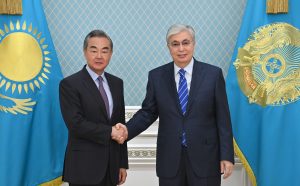Catherine Putz

Fresh off pinging around the Pacific in a race with Australian diplomats, Chinese Foreign Minister Wang Yi arrived in Nur-Sultan, Kazakhstan’s capital, for the third meeting of the China+Central Asia Foreign Ministers, or C+C5.
As summer breaks across the northern hemisphere and the pandemic’s hampering of travel fades, the geopolitical games are heating up. Central Asia is another arena in which the world’s great powers seek to extend a hand and hope to secure influence and support.
Wang’s arrival in Central Asia came in the wake of a quiet tour by U.S. Assistant Secretary of State for South and Central Asian Affairs Donald Lu in late May. Lu traveled to Kyrgyzstan, Uzbekistan, Tajikistan, and Kazakhstan and after the trip remarked, via tweet, that the C5+US “is stronger than ever!”
Japan was actually the first country to hold meetings in the C5+1 format with Central Asia, back in 2004, followed by South Korea and the European Union. The United States began holding C5+1 format meetings in 2015 as an attempt to deepen ties with Central Asia as a region (and importantly, without the domineering presence of Russia or China). China began holding such grouped summits in 2020.
For decades, China had been pursuing relations bilaterally with these countries, or within the context of larger regional groupings that included Russia, like the Shanghai Cooperation Organization. With its 5+1 China has graduated to a more narrow regional arrangement…
… The creation of the new format is an expansion of China’s role in the region and a signal of its readiness to compete for influence in the region when needed.
Toward the end of the Chinese readout of Wang’s bilateral meeting on June 7 with Kazakh President Kassym-Jomart Tokayev ahead of the C+C5 meeting the following day, there’s this gem of a statement: “China has never sought geopolitical interests in Central Asia, and never allows non-regional forces to stir up trouble in the region.”
It’s a clear reference to the United States, and perhaps to Lu, too. As Lu was embarking on his Central Asia tour, former Pakistani Prime Minister Imran Khan repeated in a CNN interview his unsubstantiated allegation that the United States — and Lu specifically — engineered his April ousting.
The readout warned the region to be “on guard against attempts by forces outside the region to draw regional countries into major power conflicts and force them to take sides” and laid out Beijing’s hopes that “Central Asian countries will stand firm, eliminate interference, strengthen coordination, cooperate in good faith and safeguard regional peace and stability.”
As for the C+C5 meeting itself, while all five Central Asian countries were represented it was curious to see the Tajik foreign minister skip the meeting, sending Minister of Transport Azim Ibrohim instead. In regard to outcomes, the six countries reportedly came to a consensus on 10 points touching on topics like Belt and Road cooperation, connectivity, maintaining regional security, and so on. China included a point on jointly implementing the Global Security Initiative, which again belies the statement that Beijing doesn’t seek geopolitical gains in the region.
In April, at the Boao Forum for Asia’s annual conference in China, Chinese President Xi Jinping proposed the Global Security Initiative, to “uphold the principle of indivisible security, build a balanced, effective and sustainable security architecture, and oppose the building of national security on the basis of insecurity in other countries.” As Rajeswari Pillai Rajagopalan noted in an article about the initiative:
Many of the proposals in the GSI are a thinly veiled effort to compete with the United States and its partners and allies. When Xi says “say no to group politics and bloc confrontation” or criticizes “small circles,” there can be little doubt that he is targeting security partnerships that the United States is anchoring in the Indo-Pacific, such as those that include India, Australia, Japan, South Korea, Taiwan, and others. Not only are these proposals driven by China’s effort to compete with the United States, but they are yet again hypocritical considering that China itself has had close alignments with states, such as the Soviet Union in the past, and continues to have long-lasting security partnerships with both Pakistan and North Korea. And, of course, Putin and Xi signed earlier this year what can easily be characterized as a new security partnership.
Turning back to the C+C5 meeting, the parties agreed to work toward a heads of state summit and with an eye toward “post-pandemic recovery” there has been renewed discussion of regional transport corridors, particularly the China-Kyrgyzstan-Uzbekistan Railway project. The initiative is of increased importance for the countries involved, particularly Kyrgyzstan, where leaders have pushed for the long-discussed rail line to finally move forward.
But while such projects are priorities for the states of Central Asia, China’s diplomacy in the region — including on such locally relevant initiatives — fits within its geopolitical contest with the United States. The same is true in reverse. U.S. regional efforts fit into Washington’s wider aims, and Central Asia is a region hemmed in by the United States’ main foes: China and Russia.
Beijing might say in readouts that there’s no geopolitics wrapped up in its engagements in Central Asia, but it’s plain to see.
No comments:
Post a Comment